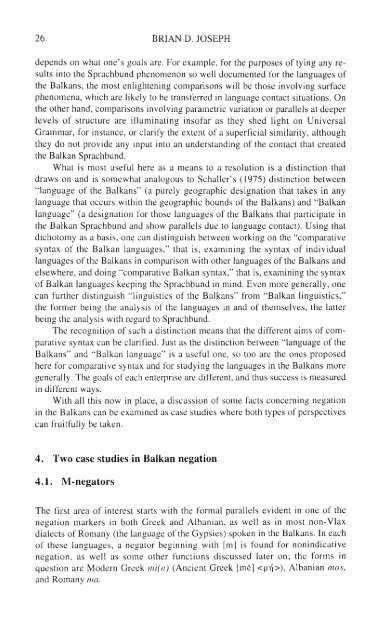Comparative Syntax of the Balkan Languages (Oxford ... - Cryptm.org
Comparative Syntax of the Balkan Languages (Oxford ... - Cryptm.org
Comparative Syntax of the Balkan Languages (Oxford ... - Cryptm.org
- No tags were found...
Create successful ePaper yourself
Turn your PDF publications into a flip-book with our unique Google optimized e-Paper software.
26 BRIAN D. JOSEPHdepends on what one's goals are. For example, for <strong>the</strong> purposes <strong>of</strong> tying any resultsinto <strong>the</strong> Sprachbund phenomenon so well documented for <strong>the</strong> languages <strong>of</strong><strong>the</strong> <strong>Balkan</strong>s, <strong>the</strong> most enlightening comparisons will be those involving surfacephenomena, which are likely to be transferred in language contact situations. On<strong>the</strong> o<strong>the</strong>r hand, comparisons involving parametric variation or parallels at deeperlevels <strong>of</strong> structure are illuminating ins<strong>of</strong>ar as <strong>the</strong>y shed light on UniversalGrammar, for instance, or clarify <strong>the</strong> extent <strong>of</strong> a superficial similarity, although<strong>the</strong>y do not provide any input into an understanding <strong>of</strong> <strong>the</strong> contact that created<strong>the</strong> <strong>Balkan</strong> Sprachbund.What is most useful here as a means to a resolution is a distinction thatdraws on and is somewhat analogous to Schaller's (1975) distinction between"language <strong>of</strong> <strong>the</strong> <strong>Balkan</strong>s" (a purely geographic designation that takes in anylanguage that occurs within <strong>the</strong> geographic bounds <strong>of</strong> <strong>the</strong> <strong>Balkan</strong>s) and "<strong>Balkan</strong>language" (a designation for those languages <strong>of</strong> <strong>the</strong> <strong>Balkan</strong>s that participate in<strong>the</strong> <strong>Balkan</strong> Sprachbund and show parallels due to language contact). Using thatdichotomy as a basis, one can distinguish between working on <strong>the</strong> "comparativesyntax <strong>of</strong> <strong>the</strong> <strong>Balkan</strong> languages," that is, examining <strong>the</strong> syntax <strong>of</strong> individuallanguages <strong>of</strong> <strong>the</strong> <strong>Balkan</strong>s in comparison with o<strong>the</strong>r languages <strong>of</strong> <strong>the</strong> <strong>Balkan</strong>s andelsewhere, and doing "comparative <strong>Balkan</strong> syntax," that is, examining <strong>the</strong> syntax<strong>of</strong> <strong>Balkan</strong> languages keeping <strong>the</strong> Sprachbund in mind. Even more generally, onecan fur<strong>the</strong>r distinguish "linguistics <strong>of</strong> <strong>the</strong> <strong>Balkan</strong>s" from "<strong>Balkan</strong> linguistics,"<strong>the</strong> former being <strong>the</strong> analysis <strong>of</strong> <strong>the</strong> languages in and <strong>of</strong> <strong>the</strong>mselves, <strong>the</strong> latterbeing <strong>the</strong> analysis with regard to Sprachbund.The recognition <strong>of</strong> such a distinction means that <strong>the</strong> different aims <strong>of</strong> comparativesyntax can be clarified. Just as <strong>the</strong> distinction between "language <strong>of</strong> <strong>the</strong><strong>Balkan</strong>s" and "<strong>Balkan</strong> language" is a useful one, so too are <strong>the</strong> ones proposedhere for comparative syntax and for studying <strong>the</strong> languages in <strong>the</strong> <strong>Balkan</strong>s moregenerally. The goals <strong>of</strong> each enterprise are different, and thus success is measuredin different ways.With all this now in place, a discussion <strong>of</strong> some facts concerning negationin <strong>the</strong> <strong>Balkan</strong>s can be examined as case studies where both types <strong>of</strong> perspectivescan fruitfully be taken.4. Two case studies in <strong>Balkan</strong> negation4.1. M-negatorsThe first area <strong>of</strong> interest starts with <strong>the</strong> formal parallels evident in one <strong>of</strong> <strong>the</strong>negation markers in both Greek and Albanian, as well as in most non-Vlaxdialects <strong>of</strong> Romany (<strong>the</strong> language <strong>of</strong> <strong>the</strong> Gypsies) spoken in <strong>the</strong> <strong>Balkan</strong>s. In each<strong>of</strong> <strong>the</strong>se languages, a negator beginning with [m] is found for nonindicativenegation, as well as some o<strong>the</strong>r functions discussed later on; <strong>the</strong> forms inquestion are Modern Greek mi(n) (Ancient Greek [m£] ), Albanian mos,and Romany ma.
















